Preserving Analog Tools in a Digital World
- 20 April 2017
- ByElizabeth Wellington
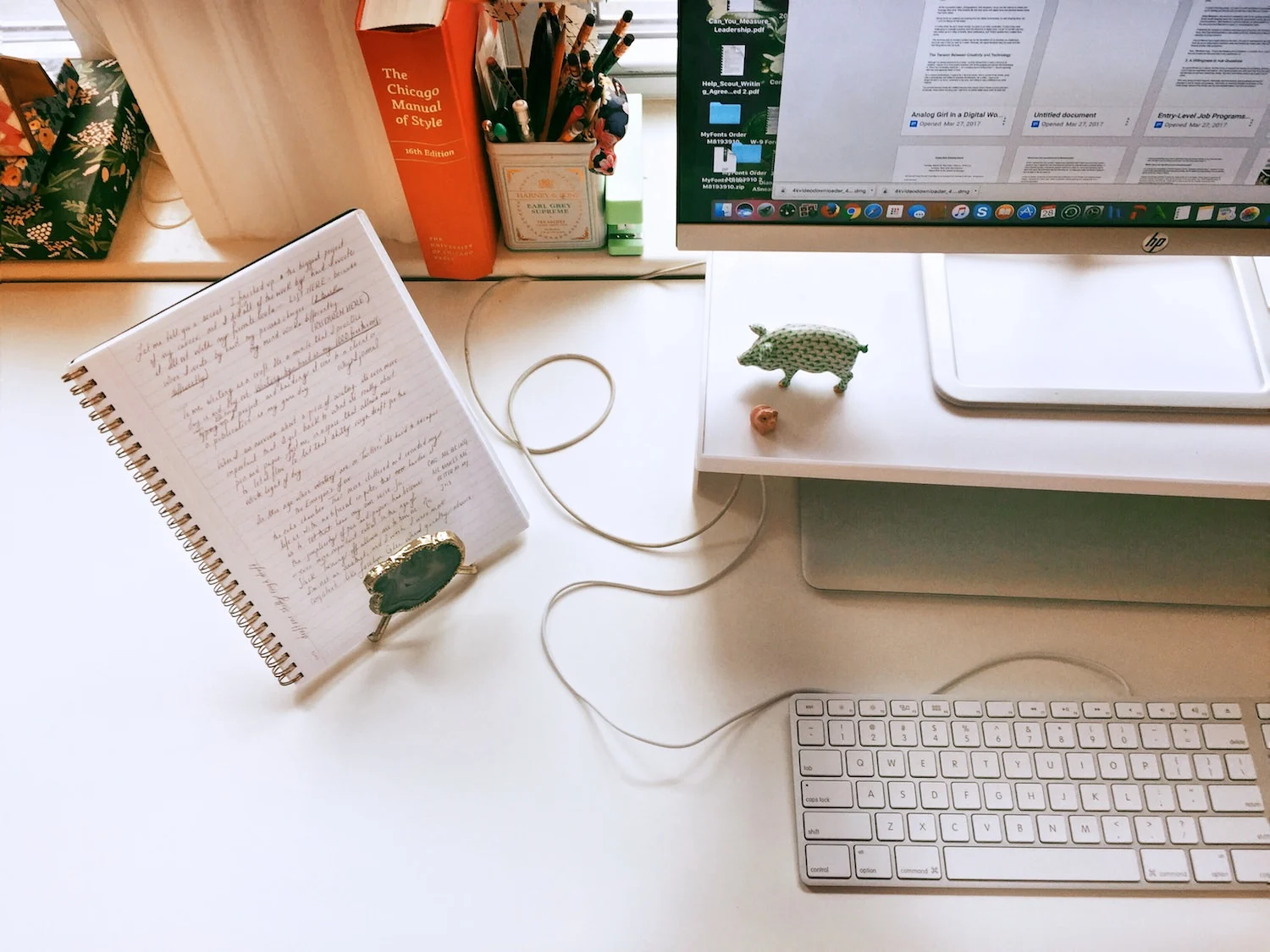
Can you name a creative who doesn’t have an email address?
I can’t.
All the successful writers, photographers, and designers I know use the internet to create and leverage their work. They breathe life into their ideas with digital tools and (almost) always share their work online.
But as much as creatives are shaping this new digital environment, it’s also shaping them, too - and not always for the better.
In a time when the term “email anxiety” is a part of our daily vocabulary, it’s becoming more challenging to untangle ourselves from the demands of digital work. I know I’m not the only one who wakes up to a volley of emails, Slack notifications, and Twitter updates from multiple time zones.
This revolving door of constant contact may be the foundation of my business, but it can also inhibit my work. And ironically, these digital demands take me away from the very thing clients pay me to do.
The Tension Between Creativity and Technology
When I started writing full time, I learned the hard way that I needed to run a business. These two demands - as a creative and an entrepreneur - require opposing skill sets and differing states of mind.
As a creative entrepreneur, I need to be a “jill of all trades” who is prompt in her emails, good with a spreadsheet, and skilled at business development. As a writer, I need to be single-minded in my focus, vulnerable in my work, and willing to value fulfillment over profit margins.
The contrast between these two realities became even clearer when I started working with tech companies. Every article and blog post I read from my clients talked about quick-fix tools that boost productivity and enable amazing remote teams. But when I tried them, they all seemed to make my creative work harder.
Yes, my business is more organized thanks to a client-mandated mashup of Trello, Slack, Quickbooks, and Google Business Suite. But as these digital demands add up and become more complex, I start to wonder how I can remain flexible - and relevant - without sacrificing the quality of my craft.
Why I Go Back to the Basics
My answer to this question is deceptively simple. I shut down my computer.
I believe digital tools are only effective when I draw strong boundaries between them and my creative process. It’s my job to make sure they never force me to take too many shortcuts or get mired in reactive work.
There’s no “hack” or time-tracking app I downloaded to strike this balance. I just put away anything that beeps, vibrates, or has a screen every morning, and I go back to pen and paper.
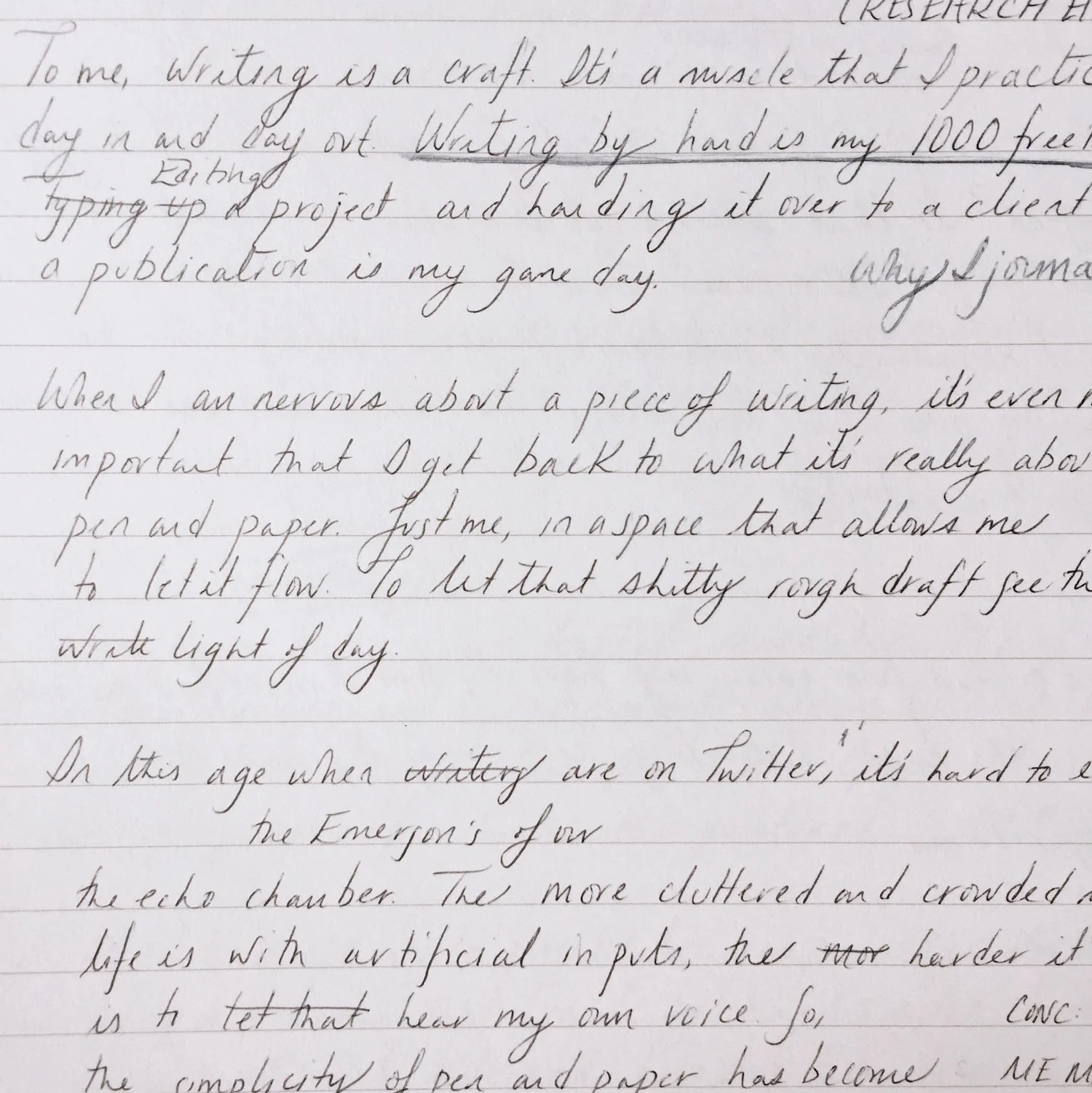
This approach works because of the simplicity it demands of me. And my pen and paper yield work that I absolutely love. I’ve found a lot of advantages to this approach. Here are some reasons why I’ll always start (and end) each project with analog tools.
Break Down Imposter Syndrome
Imposter syndrome, although prevalent in every industry, is particularly insidious in creative work. It’s easy to feel as though the projects that bring us joy don’t serve a larger purpose - and they’re not worth pursuing because we’re just not good enough.
Why write when there’s someone better out there?
To tackle this recriminating self-doubt, I turned to Julia Cameron’s The Artist’s Way and her daily practice: the morning pages. For 30 minutes, I free write, unloading whatever comes to mind to the page. By consistently ignoring my inner critic, I slowly learn to dismiss the negative voice and keep going.
For me, writing by hand is the best way to incorporate Cameron’s method into my work life. After free writing, I bring that same approach to my creative projects. When I’m writing by hand, I keep going - no matter what. I refuse to listen or adapt to any internal criticisms of my work until I start editing.
Leave Digital Distraction Behind
Every time we toggle between different tasks, we’re likely to make twice the number of mistakes. It takes us about 25 minutes to get back into a groove after each switch. Given the sheer number of “productive” digital distractions available to every creative, it’s all too easy to spend a week working and get nothing meaningful done.
Returning to paper and pen is like cushioning my creative time in bubble wrap. Because I’m using the simplest tools available, I know I’m not going to find myself on Instagram or sucked into the black hole of political news.
There’s a term for this kind of work: monotasking. Research shows that by doing less - one thing at a time - you actually get more done. The term itself may seem boring, but it’s anything but that for me.
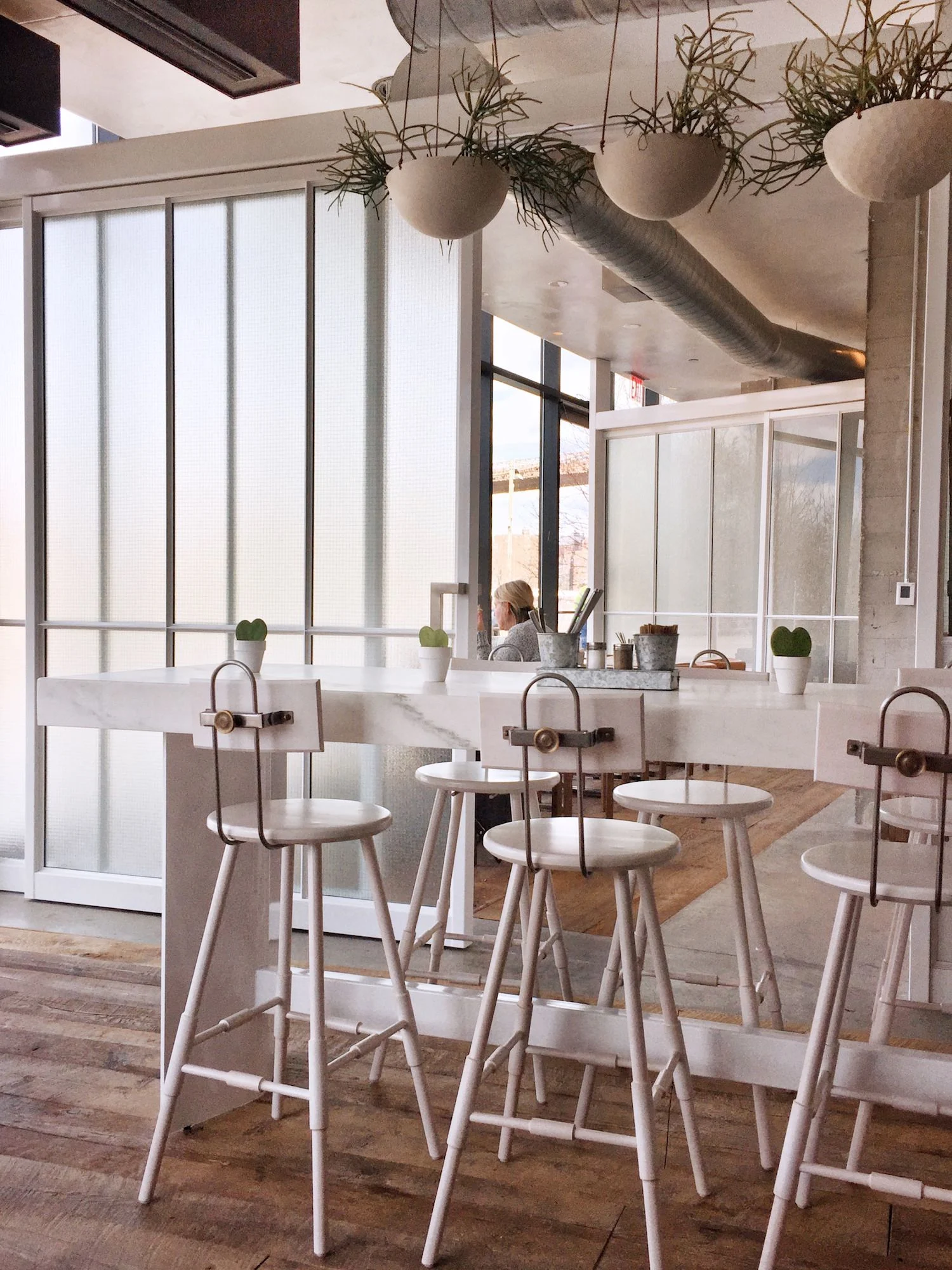
Because I’m not dragging a laptop with me, monotasking often means leaving my home office to draft a new project in the park or at a local coffee shop. I make a point of carving out time, and I leave everything else at home. Not only does this approach yield better work, it brings me joy. That matters to me, too.
Amplify Your Creativity
There are dozens of studies about the value of handwriting. When we bring a pen to paper, our brains light up in different places, we come up with better ideas (and express them with greater nuance), and we process information with greater clarity. One expert, Virginia Berninger, even believes that cursive handwriting fosters greater self-control.
When I work with a pen, ideas make their way to the page with ease, and I’m more likely to play outside the lines. I’m definitely alone in that thinking, either. Quartz reported that writers like George R.R. Martin, Quentin Tarantino, Donna Tartt, and Neil Gaiman all work by hand. So did Hemingway.
To keep pace with my ideas when I’m in the flow, I use a fast pen and a spiraled notebook that I can fold on my lap. I rarely write on the back side of a page, instead leaving it available for related notes, doodles, and ideas I want to jot down.
Get in the Flow
When I first started freelancing, I mentioned at an event that I write most of my work out by hand. Shock doesn’t begin to describe the look on these writers’ faces. Their first questions were, “Doesn’t it take forever? How do you get anything done?”
Here’s my dirty secret: because I’m in the flow, writing by hand is much more efficient for me. The drafting process helps me get to the heart of a story and allows it to spill out on the page. By the time I get to the computer, I already know what I’m trying to say.
Handwriting also takes the pressure off and eases procrastination. I recently took on a huge project with my most prestigious client, and words can’t describe how nervous I was to get started. I ended up plopping into a bubble bath and doing all the work by hand on a makeshift tub desk. It sounds crazy, but the results were outstanding. Handwriting frees me up to adapt and get in the flow, even when I want to run in the opposite direction.
A Natural Rewriting Process
With any artistic endeavor, there’s a natural refinement process. The more I embrace rewriting, the better my work becomes. And writing by hand creates a natural opportunity to elevate my prose.
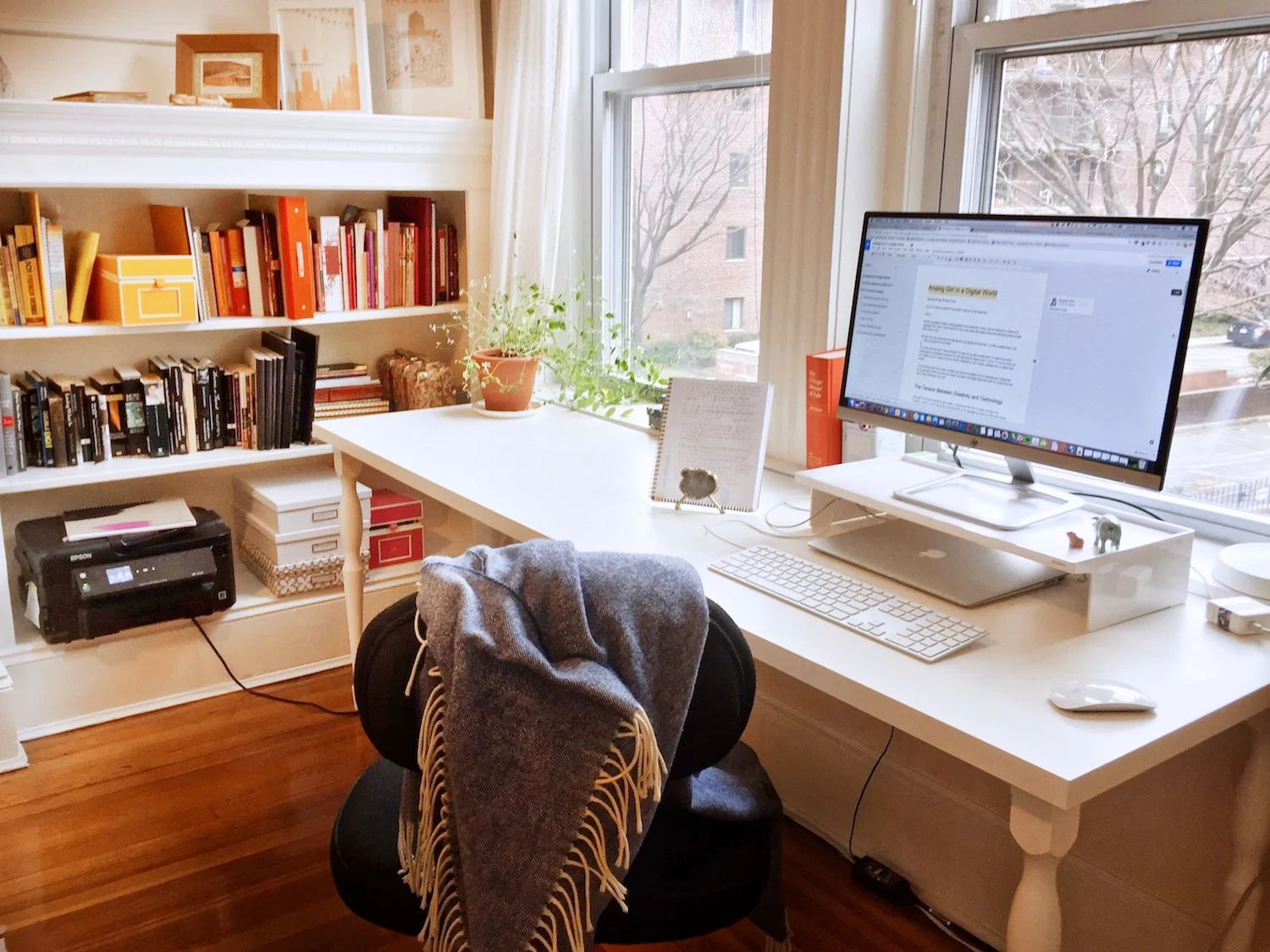
Rather than simply transcribing my writing to Google Docs, I use this step as an opportunity to edit. I keep a cookbook stand next to my computer. I set my notebook up and read through each article a paragraph at a time. I adjust the style and the structure of the article as I type it up. This process goes surprisingly fast for me.
With really challenging projects, I’ll complete a full rewrite by hand before I pop over to the computer. It helps build my confidence to know I’m inching toward something that feels cohesive.
Be a Better Editor and Proofreader
Despite my loyalty to pen and paper, I still tweak, tame, and adjust my work on the computer. But for significant editing (and that final proofread), I print out my work on recycled paper. Rather than a red pen, I grab a pencil and scribble the margins.
Maybe I’m just suspicious, but I think taking a project out of its natural environment makes proofreading easier. It feels less strenuous on my eagle eyes and makes it easier to catch out-of-place words and subtle mistakes. I always do that last edit at my kitchen table, reading each word out loud.
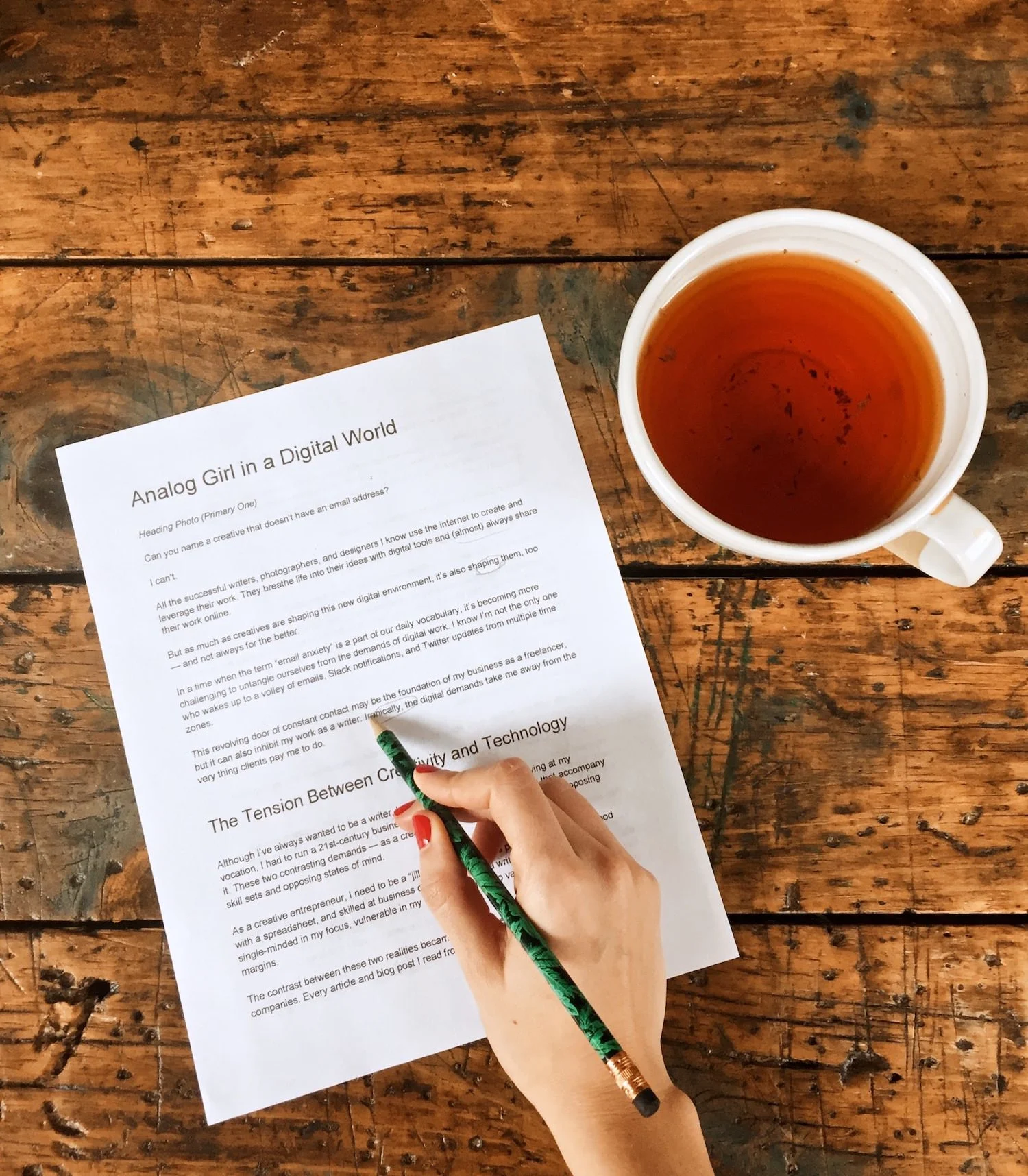
Although more manual than editing online, these extra steps have made all the difference in my career. I arrive at creative solutions with ease, and the simplicity of a pencil and paper make me feel like I’ve come full circle.
As a creative culture, we value progress. We’re always trying to reach for that next breakthrough and life-changing innovation. For many of us, the benefits of adapting to promising digital tools can outweigh challenges.
But creatives need to protect the practices that give life to our best work. By going back to our simplest tools, we create rituals that magnify our creativity and give us the canvas we need to bring real, fulfilling projects into the world.
20 April 2017
Words by:Elizabeth Wellington
Tags
- Share